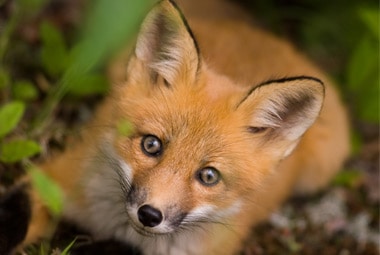
The two most common species of fox found throughout most regions of the U.S. are the red fox and gray fox. Both species are found in Missouri; the gray fox is most common in the Ozarks located in Southern Missouri, and the red fox is most commonly found north of the Missouri River.
| Pest Identification | |
|---|---|
| Recognition | Both the gray and red fox have an overall dog-like appearance but have a more elongated pointed muzzle. They both also have pointed erect ears. The gray fox is slightly smaller than the red fox. Gray Fox- The gray fox has grayish colored fur that is a coarse texture. They have dark brown eyes and their bushy tail has a black tip. Adults weigh between 5 to 15-½ pounds and can grow to be 31-¼ to 44 inches in length including the tail. Red Fox- The red fox has reddish-yellow fur that is darker in color on their backs. Their legs and feet are black in color, along with the back of their ears. Adults can grow to be 12-½ to 46 inches in length including their white-tipped tail, and can weigh between 7-½ to 15 pounds. |
| Biology | The red fox mates from December to March with most litters being born in March or April. Each female generally gives birth to 4-7 young. Red foxes dig their own dens in the ground or use the abandoned burrows of groundhogs or of other animals. When the pups reach 10 weeks of age they leave the den with their parents to learn how to hunt. In the late fall the family separates and the pups will be out on their own. The grey fox mates from January to May, with most litters being born from March to mid-May. Each female gives birth to 3 to 5 pups. Gray foxes den inside of woodpiles, brush piles, rock piles, or inside of hollow trees. At about 12 weeks of age the pups leave their den for the first time with their parents to hunt. In the late summer the pups go off on their own and the family separates. |
| Habits | Both gray and red foxes are mainly nocturnal animals, but it is not uncommon to find them out and about during the daytime hours. Both species feed on a variety of small animals including rabbits, rats, mice, wild birds, chickens, and insects. They also occasionally feed on small plants and some fruits. The gray fox prefers to live in wooded areas and in areas of open bushlands. They commonly climb trees to seek protection from predators and to warm themselves in the sun. Red foxes in contrast avoid heavily wooded areas and instead prefer to live on the boarders of woodlands, open fields and meadows. Red foxes spend most of their time on the ground, hiding in protected areas. |
| Prevention | Preventing foxes from coming onto your property is a difficult task, but there are some things that you can do to help deter them and protect any animals living on your property. If foxes are frequenting your property it is important to make sure that small dogs and cats are brought inside at night; chickens should be kept in secure coops that are surrounded by a secure mesh heavy gauge fence that is at least 5-½ feet tall. The fence should have outward-angled wire overhangs and buried wire aprons. Installing motion sensor security lights on your home, garage, chicken coops, and sheds can help to scare them away. |
| Professional | The most successful and safe way to control foxes on your property is to get help from a professional wildlife management expert. At Rottler Pest & Lawn Solutions our specially trained wildlife technicians can assist you in controlling foxes effectively and humanely. |

